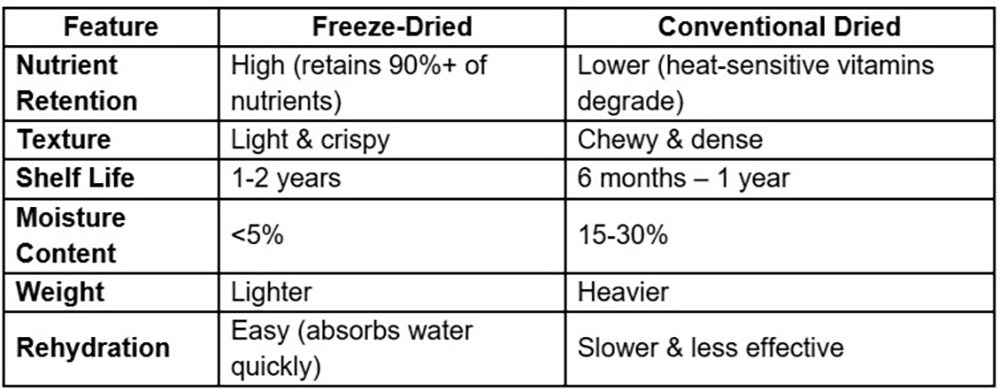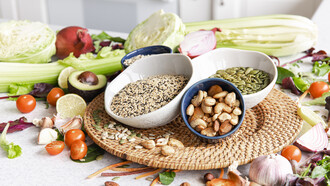From snack aisles to smoothie toppings, freeze-dried fruits have become a popular choice for health-conscious consumers. But what makes them different from conventionally dried fruits? Are they healthier, tastier, or just a marketing trend? Understanding how different drying methods affect nutrition, texture, and cost can help consumers make better choices.
Understanding drying methods
Drying is one of the oldest food preservation techniques, used for centuries to extend the shelf life of fruits. Today, two primary methods dominate the market: freeze-drying and conventional drying.
- Freeze-drying: freeze-drying is a modern technique where fruits are first frozen and then placed in a vacuum chamber. The ice inside the fruit turns directly into vapor through a process called sublimation, removing moisture without applying heat. This method preserves the fruit’s original shape, color, and most importantly, its nutritional content.
Real-life example: NASA has been using freeze-dried foods for astronauts since the 1960s. Imagine being in space and still enjoying the fresh taste of strawberries!
- Conventional drying (Air/Sun/Heat Drying): traditional drying methods involve removing water through heat and air circulation. Examples include sun-drying, oven-drying, and dehydration. While this method is effective and widely used, exposure to heat can cause nutrient loss, particularly vitamin C and antioxidants, which are sensitive to high temperatures.
Real-life example: think of sun-dried tomatoes or dried apricots you find in markets. These chewy, darkened fruits have been heat-dried, leading to a more concentrated flavor but a slight reduction in nutrients.
Key differences between freeze-dried & conventional dried fruits
Pros & cons of freeze-dried fruits
Pros
Nutrient-dense: Freeze-dried fruits retain 90-95% of their nutrients, making them one of the healthiest preservation methods. In comparison, heat-dried fruits lose up to 50% of their vitamin C.
Long shelf life: due to the removal of almost all moisture, freeze-dried fruits can last up to two years without preservatives.
Lightweight & portable: perfect for travelers, hikers, and astronauts! A 50g pack of freeze-dried berries can replace 300g of fresh berries.
Versatile usage: great for cereals, yogurt, smoothies, baking, and even gourmet dishes.
Real-life example: in the food industry, freeze-dried fruit powders are used to flavor protein shakes and desserts without artificial additives. Have you ever tried a strawberry-flavored yogurt? It probably contains freeze-dried fruit powder!
Cons
Expensive: due to advanced technology and long processing time, freeze-dried fruits cost 2-3 times more than traditional dried fruits.
Fragile texture: They crumble easily, making them less ideal for cooking compared to conventional dried fruits.
Less hydrating: since they lack water, they don’t provide the same level of hydration as fresh fruits.
Real-life example: if you’ve ever opened a bag of freeze-dried raspberries, you know how delicate they are. They can turn into powder with just a squeeze, which is great for smoothies but not ideal for trail mixes.
Conclusion
Both freeze-dried and conventionally dried fruits have their place in the food world. Freeze-dried fruits are ideal for those looking for maximum nutrition, shelf life, and convenience, while conventional dried fruits are a great, affordable, and chewy snack option. Your choice depends on your budget, intended use, and dietary preferences.
Next time you’re shopping for dried fruits, check the labels and choose what fits your needs best. Whether you’re snacking on chewy dried mangoes or crispy freeze-dried apples, both options are a tasty way to enjoy fruit all year round!
Uses & recipes for freeze-dried fruits
Common uses of freeze-dried fruits
Freeze-dried fruits are incredibly versatile and can be used in various ways, from everyday snacks to gourmet dishes. Here are some common areas where they are used:
Breakfast & snacks: sprinkled over yogurt, oatmeal, or smoothie bowls. Mixed into granola and trail mix for added crunch.
Baking & desserts: used in cakes, muffins, and cookies to add natural fruit flavor. Crushed into a powder for vibrant, natural food coloring in frostings or doughs.
Beverages: infused into teas, lemonades, and cocktails. Blended into smoothies for an intense fruity taste.
Savory dishes: added to salads for a pop of flavor and texture. Used in gourmet sauces and marinades.
Emergency & outdoor foods: lightweight and long-lasting, making them perfect for hiking, camping, and astronaut food.
Based on all this information, if you'd like to consume freeze-dried fruit, here are a few recipe alternatives you can use.
Delicious recipes using freeze-dried fruits
Freeze-dried strawberry pancakes
Ingredients
- 1 cup all-purpose flour.
- 1 tbsp sugar.
- 1 tsp baking powder.
- ½ tsp salt.
- 1 egg.
- ¾ cup milk.
- 1 tbsp melted butter.
- ½ cup freeze-dried strawberries (crushed).
Instructions
- Mix all dry ingredients in a bowl.
- Whisk egg, milk, and melted butter together, then combine with dry ingredients.
- Fold in crushed freeze-dried strawberries.
- Cook pancakes on a heated pan until golden brown.
- Serve with honey, maple syrup, or extra strawberries!
Dark chocolate & freeze-dried raspberry bark
Ingredients
- 200g dark chocolate (70% cocoa).
- ½ cup freeze-dried raspberries.
- ¼ cup chopped nuts (almonds or pistachios).
Instructions
- Melt dark chocolate using a double boiler or microwave.
- Spread the melted chocolate on a parchment-lined tray.
- Sprinkle freeze-dried raspberries and nuts on top.
- Let it set in the fridge for 1 hour, then break into pieces.
Tropical bliss freeze-dried smoothie
Ingredients
- 1 cup coconut milk (or any milk of choice).
- ½ banana.
- ½ cup freeze-dried pineapple.
- ¼ cup freeze-dried mango.
- 1 tbsp honey or maple syrup (optional).
- ½ cup Greek yogurt (for creaminess).
- ½ cup ice cubes.
Instructions
- Add all ingredients to a blender.
- Blend until smooth and creamy.
- Pour into a glass and enjoy immediately!
Tip: For a creamy tropical boost, you can also add a spoonful of coconut cream!
















